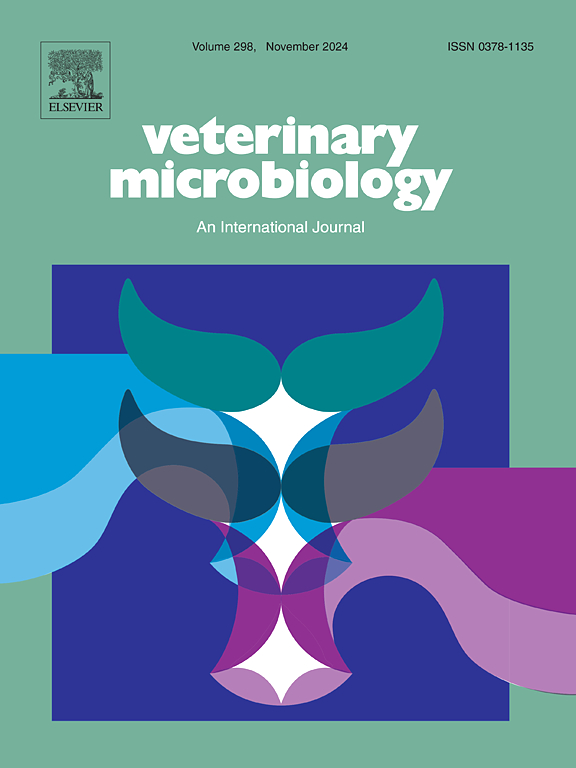猪血管紧张素转换酶2作为辅助受体增强传染性胃肠炎病毒的侵袭和复制
IF 2.7
2区 农林科学
Q3 MICROBIOLOGY
引用次数: 0
摘要
传染性胃肠炎病毒(TGEV)是引起猪腹泻的主要病原体之一,可引起新生仔猪急性严重萎缩性肠炎和致命性水样腹泻,死亡率高达100% %,给养猪业造成重大经济损失。血管紧张素转换酶2 (Angiotensin-converting enzyme, ACE2)被认为是SARS-CoV-2的入侵受体,但其在TGEV感染中的作用尚不清楚,目前对TGEV感染机制的了解尚不完整。在这项研究中,我们确定了猪ACE2 (pACE2)在TGEV感染中的重要作用。首先,不同年龄组7日龄仔猪空肠中pACE2表达量最高,免疫组化结果表明,pACE2主要分布在肠绒毛的顶端区域。功能实验表明,抑制和敲除pACE2均可减少TGEV的复制。进一步研究发现,ACE2抑制剂DX600和抗pACE2特异性抗体(阻断细胞表面pACE2)均能抑制TGEV的侵袭。同样,敲除pACE2可抑制早期TGEV感染,而补充pACE2可增强TGEV感染。机制上,共免疫沉淀证实了pACE2和TGEV-S1之间的相互作用,pACE2-TGEV-S1- rbd界面的生物信息学模型预测了两种蛋白之间的强结合趋势。点突变检测发现pACE2的Q556是这种相互作用的关键残基。相比之下,人类ACE2 (hACE2)对TGEV侵袭无显著影响。此外,研究发现pACE2促进TGEV侵袭的作用依赖于pAPN,进一步证实了pAPN是TGEV的主要侵袭受体。总之,我们的研究表明,pAPN是介导TGEV感染的主要受体,而pACE2作为依赖于pAPN的辅助受体促进TGEV感染。本文章由计算机程序翻译,如有差异,请以英文原文为准。
Porcine angiotensin-converting enzyme 2 serves as an auxiliary receptor to enhance transmissible gastroenteritis virus invasion and replication
Transmissible gastroenteritis virus (TGEV) is one of the major pathogen causing swine diarrhea, inducing acute severe atrophic enteritis and lethal watery diarrhea in neonatal piglets with up to 100 % mortality, resulting in significant economic losses to the swine industry. Angiotensin-converting enzyme 2 (ACE2) is known as an invasion receptor for SARS-CoV-2, but its role in TGEV infection remains unclear, and the current understanding of TGEV infection mechanisms is incomplete. In this study, we identified an important role for porcine ACE2 (pACE2) in TGEV infection. Firstly, pACE2 expression was highest in the jejunum of 7-day-old piglets among different age groups, and immunohistochemistry showed that pACE2 is primarily distributed in the apical region of intestinal villi. Functional experiments demonstrated that both inhibition and knockout of pACE2 reduced TGEV replication. Further studies found that both ACE2 inhibitor DX600 and anti-pACE2 specific antibodies (blocking cell surface pACE2) suppressed TGEV invasion. Consistently, pACE2 knockout inhibited early TGEV infection, while pACE2 replenishment enhanced it. Mechanistically, co-immunoprecipitation confirmed an interaction between pACE2 and TGEV-S1, and bioinformatics modeling of the pACE2-TGEV-S1-RBD interface predicted a strong binding tendency between the two proteins. Point mutation assays identified pACE2’s Q556 as a critical residue for this interaction. In contrast, human ACE2 (hACE2) had no significant effect on TGEV invasion. Additionally, pACE2’s promotion of TGEV invasion was found to be pAPN-dependent, further confirming pAPN as the primary invasion receptor for TGEV. Collectively, our study indicates that pAPN is the primary receptor mediating TGEV infection, while pACE2 functions as an auxiliary receptor dependent on pAPN to facilitate TGEV infection.
求助全文
通过发布文献求助,成功后即可免费获取论文全文。
去求助
来源期刊

Veterinary microbiology
农林科学-兽医学
CiteScore
5.90
自引率
6.10%
发文量
221
审稿时长
52 days
期刊介绍:
Veterinary Microbiology is concerned with microbial (bacterial, fungal, viral) diseases of domesticated vertebrate animals (livestock, companion animals, fur-bearing animals, game, poultry, fish) that supply food, other useful products or companionship. In addition, Microbial diseases of wild animals living in captivity, or as members of the feral fauna will also be considered if the infections are of interest because of their interrelation with humans (zoonoses) and/or domestic animals. Studies of antimicrobial resistance are also included, provided that the results represent a substantial advance in knowledge. Authors are strongly encouraged to read - prior to submission - the Editorials (''Scope or cope'' and ''Scope or cope II'') published previously in the journal. The Editors reserve the right to suggest submission to another journal for those papers which they feel would be more appropriate for consideration by that journal.
Original research papers of high quality and novelty on aspects of control, host response, molecular biology, pathogenesis, prevention, and treatment of microbial diseases of animals are published. Papers dealing primarily with immunology, epidemiology, molecular biology and antiviral or microbial agents will only be considered if they demonstrate a clear impact on a disease. Papers focusing solely on diagnostic techniques (such as another PCR protocol or ELISA) will not be published - focus should be on a microorganism and not on a particular technique. Papers only reporting microbial sequences, transcriptomics data, or proteomics data will not be considered unless the results represent a substantial advance in knowledge.
Drug trial papers will be considered if they have general application or significance. Papers on the identification of microorganisms will also be considered, but detailed taxonomic studies do not fall within the scope of the journal. Case reports will not be published, unless they have general application or contain novel aspects. Papers of geographically limited interest, which repeat what had been established elsewhere will not be considered. The readership of the journal is global.
 求助内容:
求助内容: 应助结果提醒方式:
应助结果提醒方式:


